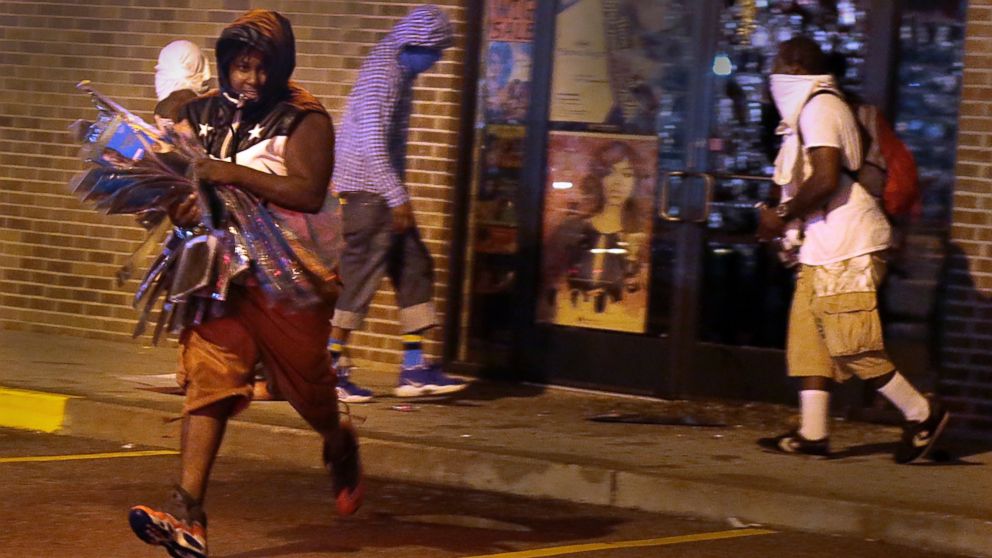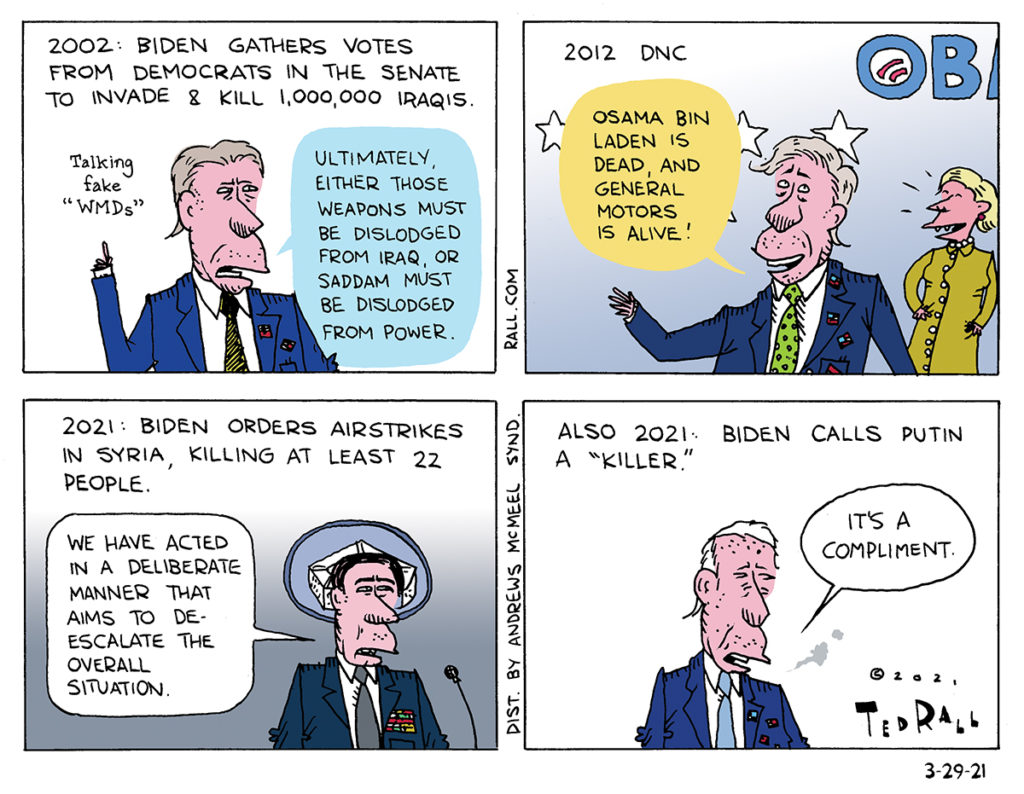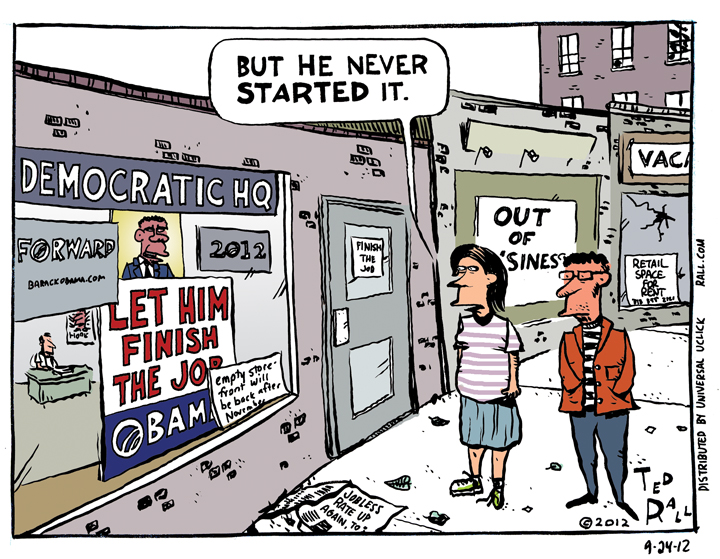In an interview President Biden called Russian president Vladimir Putin a “killer.” Obviously it takes one to know one, but what if you’re not mentally aware enough to know yourself?
SYNDICATED COLUMN: We Would Never Have Had a National Conversation on Racial Profiling if People Hadn’t Rioted in Ferguson

Ferguson, Missouri offers a lesson for those of us who are trying to make life more fair: if you want the powers that be to pay attention, violent protest is more effective than nonviolence.
At this writing, race riots following the shooting of an unarmed young black man by a white cop in a suburb of St. Louis are dominating newspaper headlines and network news coverage. Federal and state officials have taken the rare step of chastising local police authorities, with the second-guessing going so far as to include a do-over of the autopsy of the 18-year-old victim, Michael Brown.
Violent demonstrators have the attention of the attorney general and the president of the United States, the latter of whom broke away from his vacation to call for both “respect for public order and the right to peaceful public protests.” (After his administration’s coordination of the brutal crackdown against the peaceful Occupy Wall Street movement, and his decision to shunt marchers at the 2008 and 2012 Democratic National Conventions into distant, hidden, caged “free speech zones,” Obama’s defense of the right to protest is a startling 180° turn.)
After years of ignoring the problem, we are finally beginning a national conversation about police racial profiling of African-Americans, especially young men. “Driving while black,” “stop and frisk” and the militarization of local law enforcement that always seems to fall heaviest against black communities (c.f., New Orleans during Katrina) have gone on for decades — but no one besides blacks seemed to care.
Thanks to Ferguson’s rioters, mainstream (white, wealthy) America is questioning those oppressive tactics.
This is a political breakthrough. And it’s only happening because people are throwing Molotov cocktails and rocks, and breaking windows and looting, and coming out night after night to confront the police even though — arguably because — the police are shooting tear gas and rubber bullets at them.
Michael Brown’s death fits a standard narrative: White Policeman Shoots Unarmed Black Youth. Happens all the time. White cops who kill unarmed black people are rarely charged with a crime; those who get charged are rarely convicted.
As far as I can tell, no white policeman in the United States has ever received a lengthy prison term for killing an unarmed African-American civilian.
Police shootings provoke anger among the black community — and there it remains. This is because black political and religious leaders usually persuade citizens to limit their tactics to peaceful protest.
Peaceful marches don’t scare the ruling classes. Which is why they don’t lead to meaningful change.
Nonviolent protest was the reaction last month when a NYPD officer killed 43-year-old Eric Garner, suspected of selling untaxed cigarettes, using an illegal chokehold. “We’re not gonna start fighting and pushing each other and breaking windows, right?” Garner’s mother urged at a rally.
So far, the protesters’ decision to respect private property rights has had zero effect. Garner’s death was ruled a homicide, yet the cop remains at work and uncharged.
Also in New York, another unarmed 18-year-old, Ramarley Graham, was shot to death by an undercover narcotics officer who broke into his apartment without a warrant in 2012. Protesters adhered to the usual nonviolent tactics. As usual, results were nil. From The Los Angeles Times: “A judge threw out a manslaughter indictment against the officer who shot Graham on a technicality. A second grand jury failed to indict the officer, saying there was insufficient evidence to charge him. Graham’s family and local lawmakers have called for the Justice Department to investigate.”
I’m a white guy, so I don’t have to worry about getting shot by cops if I’m in a car accident. As a black man, however, Manuel Loggins, Jr. wasn’t so lucky. After Loggins wrecked his SUV, an Orange County sheriff’s deputy shot him — he was unarmed — in front of his 9- and 14-year-old daughters because he had a “mean” expression. This was in 2012. Again, there were peaceful protests. As usual, the deputy was not charged.
This is how it always goes.
Ferguson’s protesters include old-school nonviolent civil rights types as well as younger activists who are fighting back against the police in kind. At a meeting, The New York Times reported, “clergy members despaired over the seemingly uncontrollable nature of the protest movement and the flare-ups of violence that older people in the group abhorred.” The paper quoted an older man from East St. Louis: “These kids do not understand why the nonviolence movement is the best way to get done what we need to get done.”
Given how quickly the young firebrands are getting results, the old folks are the ones who don’t understand.
(Ted Rall, syndicated writer and cartoonist, is the author of “After We Kill You, We Will Welcome You Back As Honored Guests: Unembedded in Afghanistan,” out Sept. 2. Subscribe to Ted Rall at Beacon.)
COPYRIGHT 2014 TED RALL, DISTRIBUTED BY CREATORS.COM
SYNDICATED COLUMN: The Rebranding of the President, 2012
Why Is Obama Running on His Record?
“It’s not clear what [President Obama] is passionate to do if he is elected for another four years,” writes David Brooks, conservative columnist for The New York Times. “The Democratic convention is his best chance to offer an elevator speech, to define America’s most pressing challenge and how he plans to address it.”
Addressing the DNC Wednesday night, Bill Clinton came as close as any Democrat has this year to answering Brooks: “In Tampa, the Republican argument against the president’s reelection was pretty simple: We left him a total mess, he hasn’t finished cleaning it up yet, so fire him and put us back in. I like the argument for President Obama’s reelection a lot better.”
Nicely done—though this argument only works for voters stuck in the two-party trap. But the biggest piece is still MIA: Obama’s domestic and foreign policy agenda for a second term.
Two principal arguments are being advanced in favor of Obama’s reelection: first, that he “took out” Osama bin Laden; second, that we are “absolutely” better off economically than we were four years ago. These arguments, if they continue to be the Democrats’ main talking points, will lead Obama to defeat this fall.
U.S. history shows that the candidate who presents the most optimistic vision of the future usually prevails. The future he sells doesn’t have to be specific (Romney’s 12 million new jobs, say). Ronald Reagan, who projected vague aw-shucks optimism reflected by a 100%-pabulum campaign slogan, “It’s Morning in America,” defeated Jimmy “Malaise” Carter and Walter “Let’s Tell the Truth About Taxes” Mondale. (Never mind that Carter and Mondale were more honest, smarter and nicer.)
Obama followed the Reagan model in 2008: hope, change, charming smile, not a lot of specifics. And it worked. (It didn’t hurt to run against McCain, the consummate “get off my lawn, you damn kids” grouch.) So why is Obama trading in a proven winner? Why is he running on his first-term record?
Obama’s entourage has obviously talked themselves into believing that the president’s record is better than it really is—certainly better than average voters think it is. Grade inflation is inevitable when you evaluate yourself. (In 2009, at the same time the Fed was greasing the banksters with $7.77 trillion of our money—without a dime devoted to a new WPA-style jobs program—he gave himself a B+.)
First, the extrajudicial assassination of bin Laden, an act of vengeance against a man in hiding who had been officially designated to pose no threat since at least 2006, makes some people queasy. Sure, many voters are happy—but getting even for crimes committed more than a decade ago still doesn’t spell out an optimistic vision for the future.
Similarly, and perhaps more potently since jobs are the most important issue to Americans, claiming that we are better off than we were four years ago, either personally, or nationally, is a dangerous argument for this president to make. Four years ago marks the beginning of a financial crisis that continues today. GDP remains a low 1.7%. Credit remains so tight that it’s still strangling spending.
Four million families lost their homes to foreclosure, millions more were evicted due to nonpayment of rent, and a net 8 million lost their jobs under Obama. Structural unemployment is rising. New jobs are few and pay little.
Most Americans—by a nearly two-to-one margin—feel worse off now than they did four years ago. Coupled with the media’s ludicrous claim that the recovery began in mid-2009, Obama’s “who are you going to believe, me or your lying eyes” (or pocketbook) sales pitch is so insulting and reminiscent of George H.W. Bush’s tone-deaf attitude during the 1992 recession that it can only prove counterproductive.
The historical lesson for Obama is 1936. Franklin Roosevelt is the only president in recent history to have won reelection with unemployment over 8%, as it is currently (it was 17%). Why? FDR’s New Deal showed he was trying hard. And things were moving in the right direction (unemployment was 22% when he took office). Fairly or not, Obama can’t beat Romney pointing to improvement statistics don’t show and people don’t feel.
Obama must articulate a new vision, relaunching and rebranding himself into something completely different—in other words, running as though the last three four years had never happened. Like this was his first term.
New image. New ideas. New policies. New campaign slogan.
Not only does Obama need to float big new ideas, he needs to convince voters that he can get them through a GOP Congress. Not an easy task—but there’s no other way.
It isn’t enough to simply say that Romney will make things worse. Lesser-evil arguments are secondary at best. As things stand now, with people angry and disappointed at government inaction on the economy, Romney’s “Believe in America” meme—though stupid—is more potent than Obama’s reliance on fear of a Ryan budget.
(Ted Rall’s new book is “The Book of Obama: How We Went From Hope and Change to the Age of Revolt.” His website is tedrall.com. This column originally appeared at NBCNews.com’s Lean Forward blog.)
COPYRIGHT 2012 TED RALL


